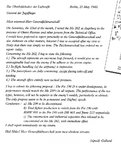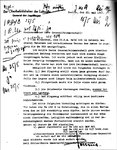This can't be authentic. It can't be. It just can't.
Galland's plea for the immediate production of the Me-262 is well known...
But look at part 'b' in the Conclusion! In May 1943, Galland recommended total fighter production be converted over to the 213A Jumo powered FW-190-D9 and the DB-603 Ta-152C.
Galland seems to be saying, "End the Me-209 program immediately, the Messerschmitt product is not as good as the favoritism and political pull that is backing it AND stop screwing around with the Jumo 213A / DB 603 pissing-match and give us both right now.
But NO, the RLM dithered another year and a half!! What in-the-hell were they thinking??
Bronc
Most esteemed Herr Generalfeldmarschall!
On Saturday, the 22nd of the month, I tested the ME 262 at Augsburg in the presence of Oberst Petersen and other persons from the Technical Office. I would have preferred to report personally to the Generalfeldmarschall and also elaborate on other matters, however I was so occupied after my visit to Sicily that there was simply no time. The Reichmarschall has ordered me to report today.
Concerning the Me 262, I beg to state the following:
1.) The aircraft represents an enormous leap forward, it would give us an unimaginable lead over the enemy if he adheres to the piston engine.
2.) In-flight handling of the airframe is impressive.
3.) The power plants are fully convincing, except during take-off and landing.
4.) The aircraft offers entirely new tactical prospects.
I beg to submit the following proposal: The Fw 190 D is under development, its performance should match the Me 209's in all respects. The performance of the two types, however, will not be superior to the enemy's models, particularly at altitude. The only progress seems to be in armament and higher speeds.
Conclusion: a) Me 209 be discontinued
b) Total fighter production to switch from the Fw 190 with BMW 801
to the Fw 190 with DB 603 and Jumo 213 respectively.
c) The construction and industrial capacities thus released to be
concentrated on the Me 262, with immediate effect.
I shall report immediately on my return.
Heil Hitler! Herr Generalfeldmarschall your most obedient servant.
Galland
Galland's plea for the immediate production of the Me-262 is well known...
But look at part 'b' in the Conclusion! In May 1943, Galland recommended total fighter production be converted over to the 213A Jumo powered FW-190-D9 and the DB-603 Ta-152C.
Galland seems to be saying, "End the Me-209 program immediately, the Messerschmitt product is not as good as the favoritism and political pull that is backing it AND stop screwing around with the Jumo 213A / DB 603 pissing-match and give us both right now.
But NO, the RLM dithered another year and a half!! What in-the-hell were they thinking??
Bronc
Adolph Galland's report regarding the Me 262
Berlin, 25 May 1943
Most esteemed Herr Generalfeldmarschall!
On Saturday, the 22nd of the month, I tested the ME 262 at Augsburg in the presence of Oberst Petersen and other persons from the Technical Office. I would have preferred to report personally to the Generalfeldmarschall and also elaborate on other matters, however I was so occupied after my visit to Sicily that there was simply no time. The Reichmarschall has ordered me to report today.
Concerning the Me 262, I beg to state the following:
1.) The aircraft represents an enormous leap forward, it would give us an unimaginable lead over the enemy if he adheres to the piston engine.
2.) In-flight handling of the airframe is impressive.
3.) The power plants are fully convincing, except during take-off and landing.
4.) The aircraft offers entirely new tactical prospects.
I beg to submit the following proposal: The Fw 190 D is under development, its performance should match the Me 209's in all respects. The performance of the two types, however, will not be superior to the enemy's models, particularly at altitude. The only progress seems to be in armament and higher speeds.
Conclusion: a) Me 209 be discontinued
b) Total fighter production to switch from the Fw 190 with BMW 801
to the Fw 190 with DB 603 and Jumo 213 respectively.
c) The construction and industrial capacities thus released to be
concentrated on the Me 262, with immediate effect.
I shall report immediately on my return.
Heil Hitler! Herr Generalfeldmarschall your most obedient servant.
Galland


